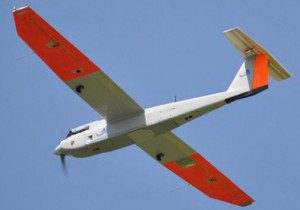
Researchers at Texas A&M University-Corpus Christi will fly RS-16 UASs into National Air Space. Click on image to enlarge.
The Unmanned Aircraft Systems Initiative at Texas A&M University-Corpus Christi has received a Federal Aviation Administration (FAA) Certification Authorization to fly RS-16 unmanned aircraft systems (UASs) into National Air Space.
The air space, which encompasses approximately 500 square miles, is unprecedented in size and versatility. The authorized area reaches several miles into the Gulf of Mexico and covers 39 miles of the Padre Island National Seashore and a substantial portion of the Laguna Madre intra-coastal waterway. Practical UAS applications include wildlife inventory, border security, hurricane research and monitoring, detection and tracking of harmful algae blooms, situational awareness for incident response and numerous others.
Flights will be made using RS-16 unmanned Tier II systems with 13-foot wingspans that are capable of staying aloft for 12-16 hours and include video, mapping, communications relay and advanced video telemetry capabilities. The aircraft will be provided by American Aerospace Advisors Inc., a UAS operator and leader in developing processes for the use of unmanned aircraft.
The UAS capability directly benefits the program in geospatial computing and significantly advances the university's competitiveness for federally funded research, said Dr. James A. Ochoa, director of the UAS initiative. In addition, this capability enables the university to serve as a leader in UAS technology training and education at both the state and national level.
Dr. L.D. Chen, associate dean of Engineering and Computing Sciences, added, The UAS capability provides an excellent opportunity for students, faculty and staff to pursue interdisciplinary research in areas important to our region.
The FAA authorization, which is one of only 15 held by universities in the United States, includes day and night flights. It also represents a major advance in the capability for academic research and education through collaboration with other major institutions working with the technology.
The University recently finalized a Memorandum of Understanding with the San Diego State University Viz Center, pointed out Dr. Flavius Killebrew, president of Texas A&M-Corpus Christi. They are one of the nation's leaders in geospatial data processing and visualization, which emphasizes collaboration in the application of unmanned system technologies for Earth sciences, incident and disaster response, and security.
Article courtesy of UAS VISION.

